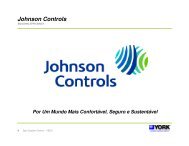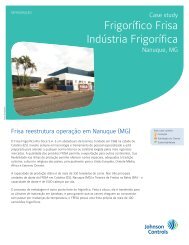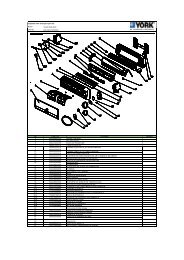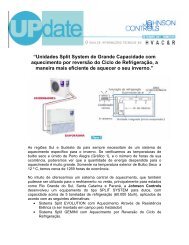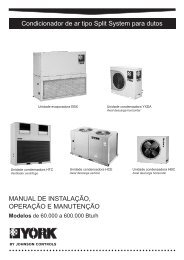Manual Técnico - Chiller YORK® Absorção YPC ... - Johnson Controls
Manual Técnico - Chiller YORK® Absorção YPC ... - Johnson Controls
Manual Técnico - Chiller YORK® Absorção YPC ... - Johnson Controls
You also want an ePaper? Increase the reach of your titles
YUMPU automatically turns print PDFs into web optimized ePapers that Google loves.
Application Data<br />
Since the machine operation is controlled by the chilling<br />
load, the amount of available heating capacity as<br />
well as the hot water temperature will vary as the chilling<br />
load varies. The graph in Fig. 3 shows the relationship<br />
between chilling capacity and heating capacity at<br />
varying energy input rates.<br />
For example, at 100% energy input rate (top curve), the<br />
machine will produce 100% chilling and no heating or,<br />
80% chilling and 20% heating, or 50% chilling and 48%<br />
heating, etc. At 80% energy input rate, the machine will<br />
produce 80% of the rated chilling capacity and no heating,<br />
or 50% chilling and approximately 28% heating, etc.<br />
WARNING – When the <strong>YPC</strong> <strong>Chiller</strong>/Heater is in<br />
the heating only (not simultaneous)<br />
mode, the mixing valve must be in<br />
the open position to allow full flow<br />
through the hot water heat exchanger.<br />
The hot water controller will<br />
then modulate the burner to meet<br />
load variations and the machine will<br />
operate in the normal manner.<br />
A standard heater is designed for a two pipe system,<br />
thus simultaneous is not possible. Heating is accomplished<br />
in the evaporator (See Fig. 5).<br />
Air Supply and Chimney System<br />
Air Supply – As with any natural gas or No. 2 Oil-fired<br />
appliance, adequate combustion air supply must be provided<br />
for proper and complete combustion. As a general<br />
rule, 12 standard cubic feet (0.34 standard cubic meters)<br />
of air are required for every 1000 Btu (1054 kJ) of fuel<br />
burned, assuming combustion with 20% excess air.<br />
In addition to direct combustion air, outside air is also<br />
needed for ventilation and as make up to any machine<br />
room air which is induced up the chimney through a<br />
barometric draft regulator.<br />
Air supply openings of adequate size must be provided<br />
to the machine room in accordance with local codes<br />
and standards. The specific location and size should be<br />
sufficient to allow an unobstructed flow of fresh air to<br />
the burner. Under no circumstances should the static<br />
pressure in the mechanical room become negative (below<br />
atmospheric pressure).<br />
Contacts are provided in the burner panel (supplied<br />
mounted on the YORK chiller-heater) to tie in the opening<br />
and closing of fresh air dampers into the start/stop<br />
sequence of the chiller. If the fresh air dampers do not<br />
open within 60 seconds, the Millennium Control Center<br />
will shut the chiller down, preventing an unsafe operating<br />
condition.<br />
Chimney Draft Theory – Draft control serves two important<br />
functions for <strong>YPC</strong> Direct Fired chiller-heaters: 1.<br />
20<br />
It removes the combustion products from the living or<br />
work space, and 2. Minimizes excess draft which pulls<br />
useful heat out of the unit and lowers its efficiency.<br />
Draft depends on two important factors: 1. The temperature<br />
difference between the flue gas and the outside<br />
air, and 2. The height of the chimney. Higher temperature<br />
differences between the flue gas and the outside<br />
air, and higher chimneys both create more draft.<br />
Chimney draft is the force created by the difference in<br />
temperature between the flue gases and the outside<br />
ambient air. The magnitude of this temperature difference<br />
is directly proportional to the draft created. Temperature<br />
difference causes draft because gases, such<br />
as air, occupy different volumes at different temperatures.<br />
For example: One cubic foot of air weighs 0.0834<br />
pounds (37.8 grams) at a temperature of 0°F. This same<br />
cubic foot of air at 450°F (232°C) weighs only 0.0422<br />
Ibs. (19.1 grams). The amount of mass per specific<br />
volume is referred to as density. Density decreases as<br />
temperature increases and lighter (lower density) air<br />
rises while heavier, more dense air sinks. This is the<br />
same phenomena that leads to air stratification in buildings.<br />
The temperature in a room at the thermostat may<br />
be 70°F (21.1°C) but the temperature near the ceiling<br />
may be 80°F (26.7°C).<br />
Heated combustion gases being less dense than the<br />
cooler outside air rise and flow out of the top of the chimney<br />
and create a partial vacuum. This causes a negative<br />
pressure at the chimney inlet that pulls in more gas for<br />
venting. This pulling force is referred to as chimney draft.<br />
Because the direct-fired chiller-heaters are capable of<br />
operating in both the heating and cooling modes, the<br />
outdoor air temperatures will change significantly from<br />
the summer (cooling season) to the winter (heating season).<br />
These wide temperature swings must be accounted<br />
for during system design. The larger the temperature<br />
difference the greater the draft. Therefore, when<br />
the unit is operating during the colder months more draft<br />
will be produced. It is essential that the chimney system<br />
be designed using summer ambient conditions so<br />
as to avoid undersizing the draft system.<br />
Chimney Design Theory – The following is a discussion<br />
of the basic terms and approach used in chimney<br />
design. It is not the intent of this section to address the<br />
fine details of proper chimney design. Because of the<br />
large number of variables, this must be addressed on<br />
an application specific basis by an experienced designer<br />
knowledgeable in chimney systems, draft control, and<br />
local code requirements.<br />
Theoretical Draft (Dt) – The definition of Theoretical<br />
Draft is the natural draft or “Chimney Effect” produced<br />
by difference in densities of hot exhaust gas relative to<br />
cooler ambient air.<br />
YORK INTERNATIONAL


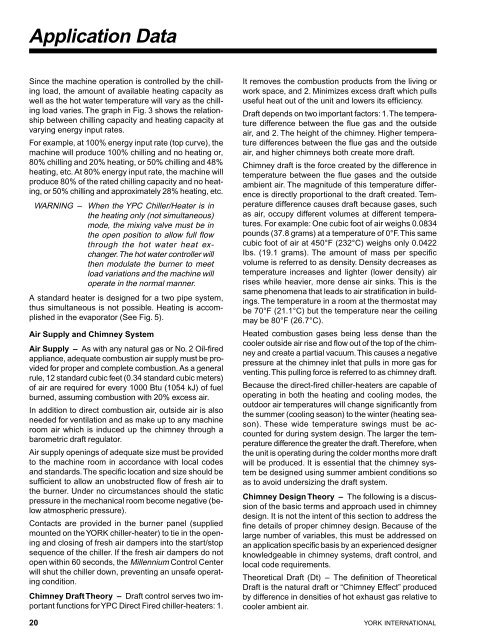
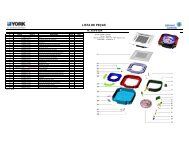

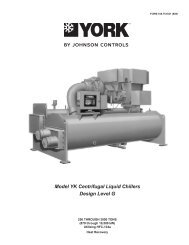
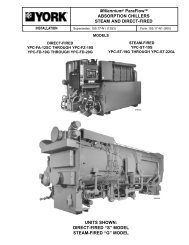
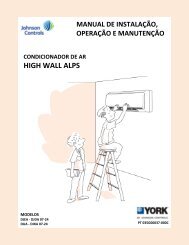
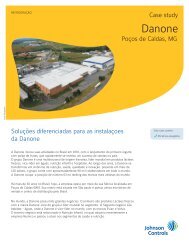
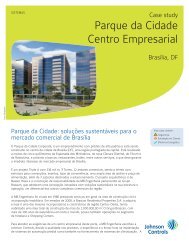

![[PDF] Catálogo Técnico YP Corrigido Corel 9 - Johnson Controls](https://img.yumpu.com/49244478/1/190x245/pdf-catalogo-taccnico-yp-corrigido-corel-9-johnson-controls.jpg?quality=85)

